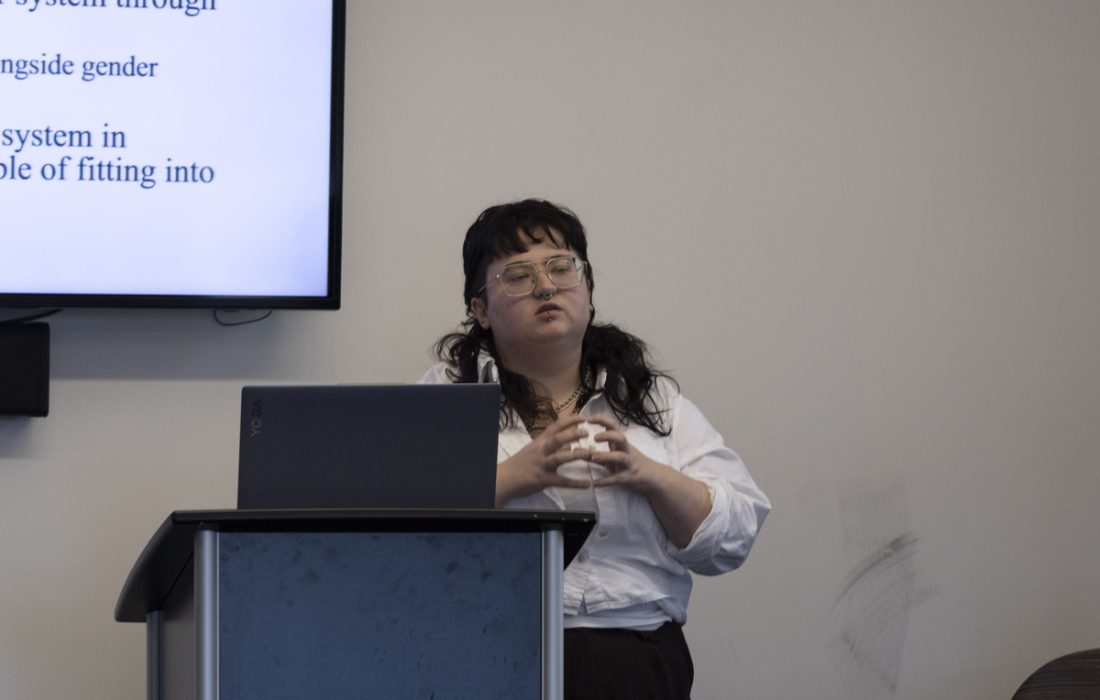Master’s student Sam Forrey presented one of their award-winning papers Nov. 2.
Loyola Masters Student Gives Presentation on Sex and Race Research
Loyola master’s student Sam Forrey presented one of their award-winning papers Nov. 2 in Cuneo Hall as a part of the Women’s and Gender Studies Feminist Lecture Series.
The paper, titled “Idealized Anatomy and the Discursive Formation of Sex in the United States and Europe,” uses historical medical studies and records to reveal how the idea of a binary sex system of male and female only arose during the 18th century Scientific Revolution to scientifically justify oppression.
“At this time, we saw an increase in sex roles and gender roles,” Forrey said during their speech. “By tying these together, oppression of women was able to be pushed forward by making it a scientific truth.”
Forrey’s work won the 2023 Mary Griffin Award from the Women’s and Gender Studies Program. The annual award celebrates the writing of a graduate student in the program and is named after Mary Griffin, BVM, a teacher at Mundelein College and later Loyola who advocated for the civil rights and feminist movements, according to the program website.
One major recurring subject of the presentation was the ability of the clinic to justify and explain discrimination under the guise of science. The clinic is the physical teaching hospital — for instance Northwestern Med or UChicago Med — where medicine, and sometimes people, are analyzed as objects of study, according to Forrey.
Using the clinic, Forrey said the dominant white, heterosexual powers in the 18th century were able to create scientific excuses for excluding those who supposedly didn’t fit the norm.
“People, specifically in this analysis Black women and eventually lesbians, were historically placed into distinct sex categories because they were and still are incapable of fitting into the anatomical ideal,” Forrey said. “This ideal, which is defined through the clinic, upholds whiteness and heterosexuality.”
One of the main methods for doing this was the emergent field of comparative anatomy, which Forrey said objectified the human body by making it an object which can be studied. Comparative anatomy first compared characteristics between species, such as between kinds of birds but eventually stretched to categorize humans as well.
“Thus, non white people, particularly Black people, became objects that could be scientifically scrutinized and compared to white people to reinforce hierarchies,” Forrey said.
In their presentation, Forrey discussed one instance where two separate comparative anatomy researchers reached opposite conclusions about the comparative sizes of Black and white women’s pelvises, and despite this opposition both still used comparative anatomy to justify racism.
One researcher said they found all Black women’s pelvises were more oblong, deeper and a degraded version of a white woman’s pelvis, according to Forrey.
Another researcher later concluded the opposite, and believed white women’s pelvises were larger to accommodate the larger heads of white infants, because they thought white babies were more advanced than Black babies and thus had larger brains and heads.
“The differing accounts about the size of Black woman’s pelvises — accounts where one is large and overdeveloped and indicative of sexuality and accounts where they are small and underdeveloped indicative of evolutionary failure — illustrate the subjectivity of the medical gaze,” Forrey said. “And how sex has been differently constructed to assert what is most beneficial socially, politically to the clinic.”
Forrey said the research for the paper took three months of scrolling through entire search results on online archives after plugging in various combos of related search terms such as “vagina,” “Black” or “clitoris.” This project isn’t Forrey’s longest to date, with their ongoing masters thesis on lesbian porn magazines in the 1980s approaching 11 months of work.
“Some of it was not super as abundantly clear what the opinions were,” Forrey said “Some of them were just like, ‘I examined a woman today and her vagina was like three inches long,’ and it’s like OK, that’s like all it is. And then some of them were much more, either overtly or were not motivated by distinguishing race.”
Although this may have not been Forrey’s longest project, the significance of the topic weighed heavily on them.
“Doing the research for this was profoundly more upsetting,” Forrey said. “Because the violence is much more, like, latent and unexpected. It’s, like, the only time I’ve cried while researching, the full articles of some of the things I read were genuinely like upsetting and disgusting. It was, like, the most eye opening research I have done in my academic career.”
The presentation lasted nearly an hour and was followed by a brief Q&A between Forrey and those who either attended in person or over Zoom.
One Zoom attendee didn’t have a question to ask Forrey but instead wished to applaud them for their research.
“It is just interesting to think about how categorically, every time the body is in that position it is transformed into an object, and how that can’t really be divorced from the history,” the attendee said. “So that’s just something that I’m taking away and thinking about.”
Forrey said they’ve found Loyola’s Women’s and Gender Studies program to be a rewarding academic experience and said they appreciate the flexibility and interdisciplinary nature of the masters program.
“It’s been great,” Forrey said. “I moved here from Cleveland. And it was, like, a big risk, because I left my job, like, I left a career. And it’s just, like, totally paid off.”
Forrey’s presentation was part of the Women’s and Gender Studies Feminist Lecture Series, with the next lecture in the series about Embodying Reproductive Agency with Plant Medicines set for Nov. 16, according to the program website.
This article was written by Hunter Minné
Featured image by Ryan Pittman

